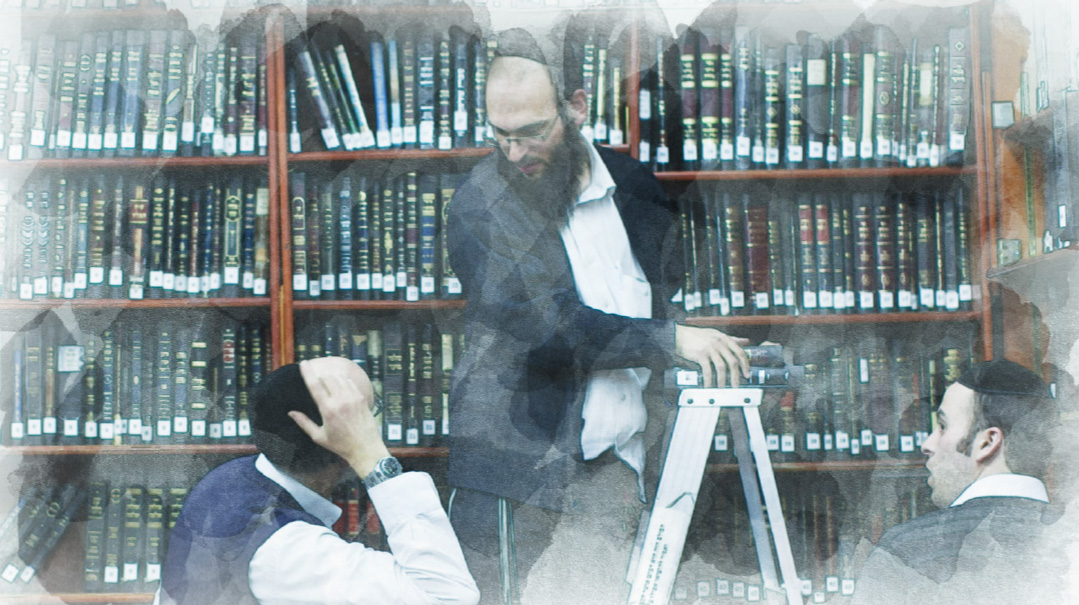From the Mountain to the People

Rav Uri Deutsch shares Shavuos insight and inspiration

Illustration: Ayala Shooter
Photos: Agudath Israel of America Archives, Flash90
Shavuos commemorates the moment when we stood before a humble mountain, watching as all of creation stood still and the roar of the Devar Hashem reverberated from a Heavenly sphere now open wide. It was the day that changed the course of history; ever since that encounter we would be a People guided by a divinely outlined mission.
The force of Matan Torah continues to this day — transmitted through a kol gadol v’lo yasaf — but the clarity has been obfuscated. Questions swirl and challenges abound, but a People who cling to Truth continue to seek truth.
Hashem, in His infinite kindness, has entrusted the many kehillos of Klal Yisrael with rabbanim to guide us, to hear our doubts and provide clear direction. Today, Rav Uri Deutsch shlita serves as the much beloved mara d’asra of Lakewood’s Forest Park community, and he has graciously consented to devote some of his precious time to share these insights with our readership.
On this zeman Matan Toraseinu, these divrei chizuk and hadrachah make our kabbalas haTorah that much more personal, tangible, and enduring.

We asked:
The Shelah Hakadosh cites the teaching of the Tola’as Yaakov that Shavuos is the “Yom Hadin” for Torah. The idea of a “Yom Hadin” brings to mind a day filled with fear, awe, and intensity. Yet Shavuos is celebrated as a day of joy, very different from the tenor of Rosh Hashanah. How can this be reconciled with words of the Shelah?
This question is predicated on the assumption that a Yom Hadin must inspire some element of fear, of eimas hadin.
But the truth is that a day of judgment doesn’t necessarily translate into a day of trepidation and fear. The Vilna Gaon writes in Biur HaGra that the reason why we don’t say Tachanun on Tu B’Shevat is because it is Rosh Hashanah L’ilanos (a new year for the trees). He explains that every Rosh Hashanah is a day of simchah, and therefore there is no Tachanun.
Rosh Hashanah itself does inspire fear in us, because as the gemara in Eiruchin tells us, “sifrei chaim v’sifrei meisim pesuchim l’fanav — the books of life and the books of death are opened before Him.” But the isolated quality of a Yom Hadin in and of itself, does not warrant the fear we associate with Rosh Hashanah.
In fact, Pesach is also a Yom Hadin — it is then that we are nidon al hatevuah, we are judged on the grain, and Shavuos is when we are nidon al peiros ha’ilan, judged on the fruit of the tree. And they are both joyous Yamim Tovim, days of simchah and not fear.
As cited in the question, the Shelah teaches us that the judgment of Shavuos is not only on actual fruit, but also alludes to a more transcendent form of peiros — Torah and mitzvos. The term “peiros ha’ilan,” therefore, refers to spiritual fruits in addition to physical ones.
This is in line with an idea taught by the Maharal in Gevuras Hashem that all phases in the agricultural cycle are indicators of something transpiring in the Upper Worlds. Therefore, whenever the Torah describes a Yom Tov in agricultural terms, in addition to the scientific reality, it is also hinting to spiritual potential unique to that time period.
The pasuk refers to man as a “tree” — “ki ha’adam eitz hasadeh.” On Shavuos, when the “fruits of the tree” are judged, this includes all of man’s spiritual accomplishments. In this light, rather than perceiving Shavuos as a day of fear, it should be seen as a day of opportunity, a day to connect and to bond oneself with all the ideals that the Torah sets out for us. That is what Yom Hadin means in this context. The more one strives to internalize, and sublimate, the message and ideals of Torah, the more he will merit the siyata d’Shmaya to realize his innate spiritual potential.
It’s important to for us to take note that whereas the minhag in Klal Yisrael is to signify the centrality of Shavuos as the Yom Shenitna Bo Torah primarily through limud haTorah, there is a more generally applicable component as well. Anashim, nashim, v’taf were present at Har Sinai, even though limud haTorah is primarily the mitzvah of anashim.
This is because Matan Torah was the experience of bonding with the Torah, fusing it as one with our nefesh, and this is equally relevant to all of Klal Yisrael.
The pasuk describes the shofar blast at Har Sinai as a “kol gadol v’lo yasaf — a great sound that never ends.” The Chassid Yaavetz writes that anytime someone engages in any level of investment in Torah learning, the level of understanding gained at that moment is akin to nevuah. Comprehending Torah is to access something beyond our natural world.
Consequently, relating to Shavuos as a Yom Hadin means to incorporate this capability, to ensure that our actions and mindsets are molded according to the ideals of the Torah.
Oops! We could not locate your form.







